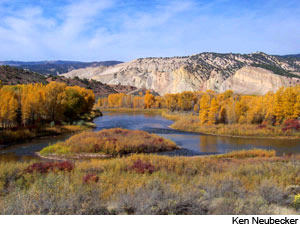
Upper Colorado River lands sixth spot on America’s Most Endangered Rivers list
June 4, 2010 —
Virtually everyone who lives in Eagle County knows the value of the Colorado River. Lacking any major lakes or reservoirs, it’s basically our primary water feature – our beachfront if you will.
But the scenic Upper Colorado River between its headwaters in Rocky Mountain National Park and its confluence with the Roaring Fork River in Glenwood has landed the sixth spot on the America’s Most Endangered Rivers list.
Threatened by two major diversion projects that would suck even more of its flow from the Western Slope to the middle-of-the-day, Kentucky-bluegrass, sidewalks-and-street-watering environs of the Front Range, the once-mighty Colorado is in big trouble, according to a report by American Rivers.
The national nonprofit group, in concert with other conservation groups such Colorado Trout Unlimited, is calling on the U.S. Army Corps of Engineers and the Bureau of Reclamation to require conservation and efficiency measures in the Final Environmental Impact Statements (FEIS) for both the Moffat Tunnel Collection System Project and the Windy Gap Firming Project.
“We can’t continue to take and take water from the Upper Colorado without accounting for the serious impacts to fish and wildlife habitat,” Colorado Trout Unlimited’s Ken Neubecker said in a release. “This is a river on the brink. A vibrant, healthy river system in the Upper Colorado is every bit as important to the future of Colorado as the water it supplies to our farms and cities.”
Recent media coverage has also focused on the growing demands on the Colorado for energy production, including hydroelectric in Glenwood Canyon and oil and gas development further downstream in Garfield and Mesa counties.
The Upper Colorado, though, is a recreational paradise, with world-class whitewater and gold-medal trout fishing. It runs through the heart of the state’s most popular mountain resorts from Grand County to Glenwood Springs, with its tributaries supplying water to ski towns like Breckenridge and Vail. It’s a perennial candidate for federal Wild and Scenic River designation.
Other groups have cropped up in recent weeks to help stem the tide of diversion projects pulling more and more water from the Colorado and reducing its overall quality and aquatic habitat value. Spearheaded by New Belgium Brewing and the Clean Water Fund, Save the Colorado is donating funds to environmental non-profits in the Colorado River basin promoting water conservation. Save the Colorado is accepting grant applications throughout June.
But a pair of articles on the future of two very different Colorado rivers last week in the Grand Junction Daily Sentinel and the Denver Post surfed right past the very real environmental concerns presented by ongoing energy development.
The Sentinel looked at how Xcel Energy’s Shoshone 14-megawatt hydroelectric power plant on the Colorado River in Glenwood Canyon could become a bargaining chip in the seemingly endless tug of war between Front Range and Western Slope water users.
Denver Water and Xcel control the senior right pumping Colorado River water through Shoshone’s turbines, but Western Slope stakeholders, in the form of the Colorado River Water Conservation District, would love to have more say in how the facility is managed. Denver Water wants more certainty in terms of future water supplies for residential growth.
The elephant in the room is all the conflicting uses along the high-profile Colorado River – the main source of water for much of the southwestern United States. Energy companies for decades have been buying up senior rights along the river, planning for increased development of natural gas and someday maybe oil shale.
But those are very thirsty endeavors that don’t jibe well with increasing demands for residential growth along the Front Range and on the Western Slope, agricultural needs, or outdoor recreation demand in the form of fishing, boating and snowmaking for winter sports.
The ongoing water wars are putting more and more pressure on the Colorado and its headwater tributaries, with trickle-down water-quality and riparian habitat impacts all the way to the Gulf of California – the currently less-notorious gulf on the other side of Mexico.
The Denver Post last week explored the little-known Dolores River, where water diversion for agricultural and industrial purposes in the Cortez area has reduced flows on the 250-mile river by about 40 percent, or 100,000 acre-feet a year.
Flowing out of Colorado’s scenic San Juan Mountains in the southwestern corner of the state, the Dolores joins the Colorado in eastern Utah northwest of Moab. That area for years has been a hotbed for the mining of uranium and other toxic metals, and given the promise of a new “nuclear renaissance” to reduce fossil-fuel consumption, uranium speculation in the Dolores basin is on the rise. Environmental groups are battling in court to slow those impacts to what the Post dubs the state’s “forgotten river.”
![]() Comment on "Upper Colorado River lands sixth spot on America’s Most Endangered Rivers list" using the form below
Comment on "Upper Colorado River lands sixth spot on America’s Most Endangered Rivers list" using the form below












